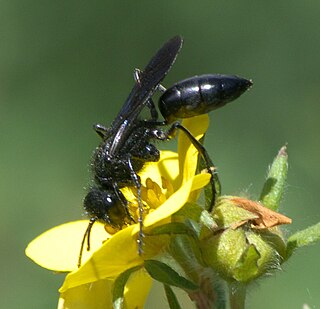
The Sphecidae are a cosmopolitan family of wasps of the suborder Apocrita that includes sand wasps, mud daubers, and other thread-waisted wasps.

Mud dauber is a name commonly applied to a number of wasps from either the family Sphecidae or Crabronidae that build their nests from mud; this excludes members of the family Vespidae, which are instead referred to as "potter wasps". Mud daubers belong to different families and are variable in appearance. Most are long, slender wasps about 1 inch (25 mm) in length. The name refers to the nests that are made by the female wasps, which consist of mud molded into place by the wasp's mandibles. Mud daubers are not normally aggressive, but can become belligerent when threatened. Stings are uncommon.

Sceliphron is a genus of Hymenoptera of the Sphecidae family of wasps, commonly referred to as mud daubers. They are solitary and build nests made of mud. Nests are frequently constructed in shaded niches, often just inside of windows or vent openings, and it may take a female only a day to construct a cell requiring dozens of trips carrying mud. Females will add new cells one by one to the nest after each cell is provisioned. They provision these nests with spiders, such as crab spiders, orb-weaver spiders and jumping spiders in particular, as food for the developing larvae. Each mud cell contains one egg and is provided with several prey items. Females of some species lay a modest average of 15 eggs over their whole lifespan. Various parasites attack these nests, including several species of cuckoo wasps, primarily by sneaking into the nest while the resident mud dauber is out foraging.
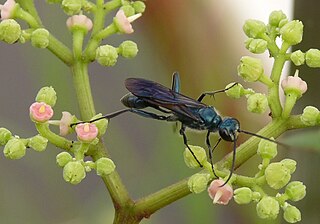
Chalybion is a genus of blue mud dauber wasps in the family Sphecidae.

Sceliphron curvatum is an insect in the genus Sceliphron of the wasp family Sphecidae. Like all wasps of this genus, it is a solitary species and builds nests out of mud. S. curvatum is native to some regions of Asia and invasive to Europe.

Sceliphrinae is a subfamily of thread-waisted wasps in the family Sphecidae. There are about 6 genera and at least 140 described species in Sceliphrinae.

Sceliphron laetum is a wasp in the family Sphecidae, the mud-dauber wasps. Like other members of this genus, it is a solitary species and builds cells out of mud in which to rear its young, provisioning them with paralysed spiders, and laying an egg in each. This wasp is native to Australia and southeastern Asia.
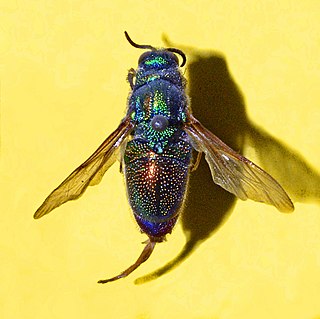
Stilbum cyanurum, the large cuckoo wasp, is a species of cuckoo wasps.
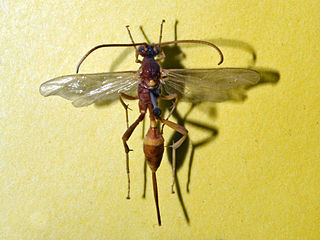
Acroricnus seductor is a species of wasp belonging to the family Ichneumonidae.
Podalonia robusta is a species of thread-waisted wasp in the family Sphecidae.
Ammophila placida is a species of thread-waisted wasp in the family Sphecidae.
Palmodes dimidiatus is a species of thread-waisted wasp in the family Sphecidae.
Palmodes is a genus of thread-waisted wasps in the family Sphecidae. There are more than 20 described species in Palmodes.
Aphilanthops is a genus of ant queen kidnapping wasps in the family Crabronidae. There are at least four described species in Aphilanthops.
Ammophila azteca is a species of thread-waisted wasp in the family Sphecidae.
Plenoculus davisi is a species of square-headed wasp in the family Crabronidae. It is found in North America.
Anacrabro is a genus of square-headed wasps in the family Crabronidae. There are about 15 described species in Anacrabro.
Sceliphron assimile is a species of thread-waisted wasp in the family Sphecidae.
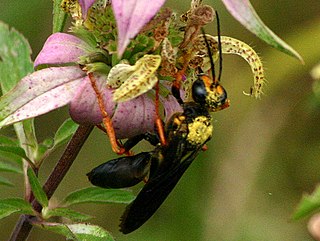
Sphex flavovestitus is a species of thread-waisted wasp in the family Sphecidae.
Sceliphron asiaticum is a species of thread-waisted wasp in the family Sphecidae. It is native to the Neotropics, South America and the Caribbean region.









